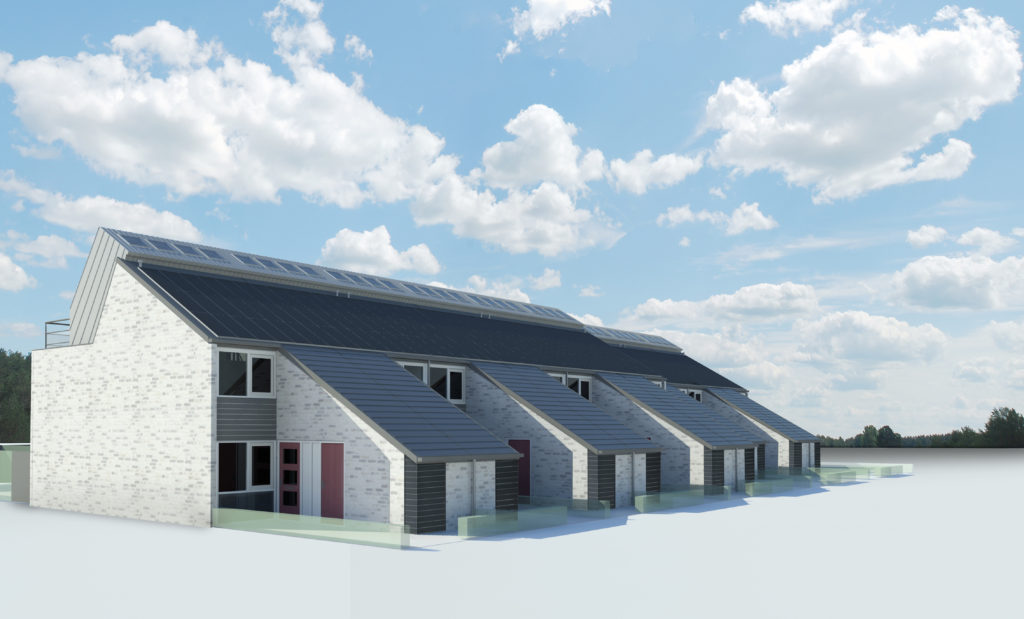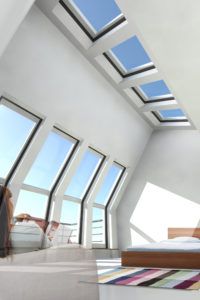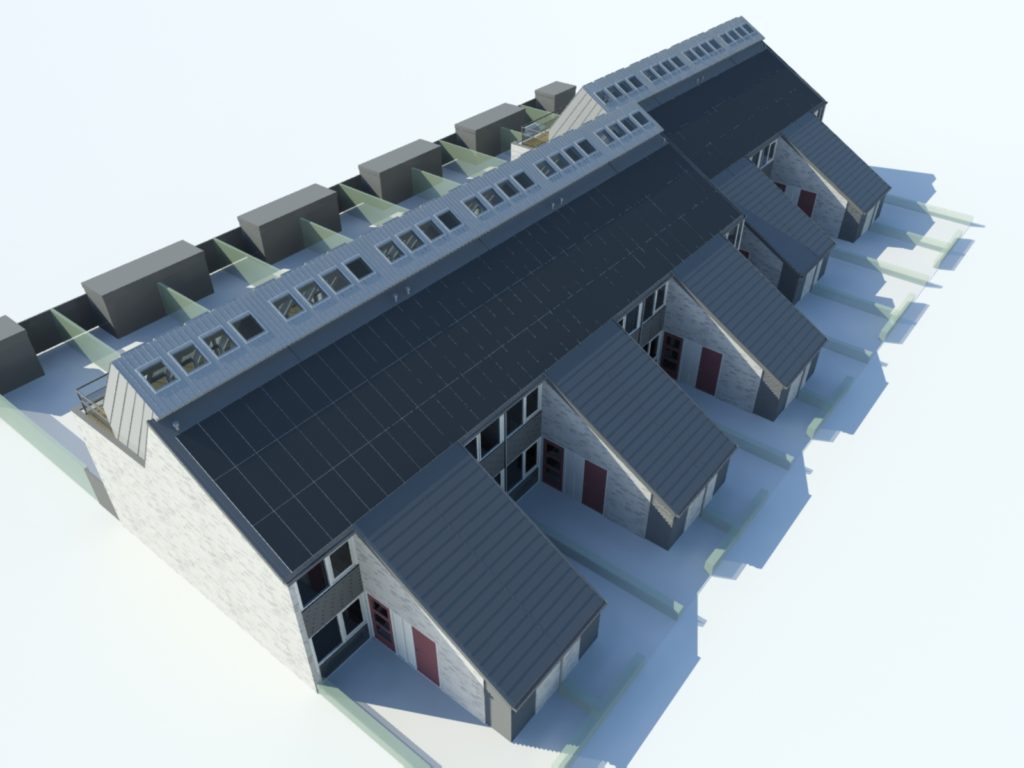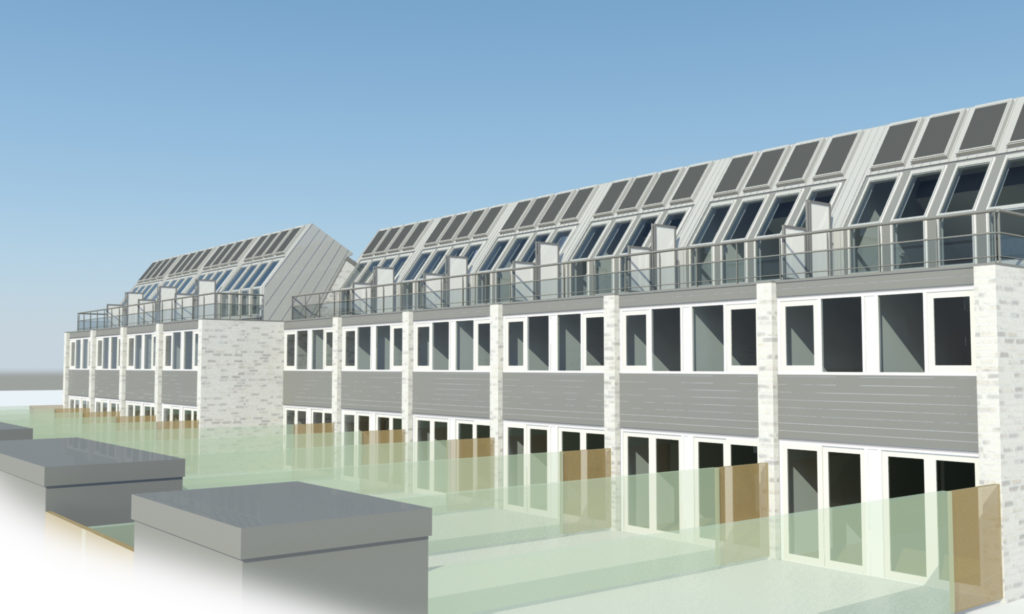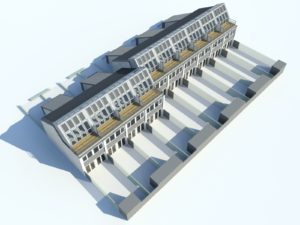Transformation Poorters van Montfoort
In Montfoort ten existing dwellings, built in 1975, will now be transformed into Active House. The energy performance of the existing complex shows the average performance. Energy label E, according to the Energy Performance Building Directive protocol. One of the main aspects of Active House is energy. Enhancing the energy performance of the building is prominent. At this moment the facades are only insulated on a medium level. The same goes for the roof. With the Active House transformation it will exceed the new build quality level.
The following measures will be applied to reduce loss of energy: new insulation slabs on the roof, new outer wall with added insulation, new windows frames with triple glazing and insulation will be applied under the ground floor.
Furthermore installations are needed to comply to the indoor specifications with a energy consumption as low as possible. Therefore the following installations are part of the plan: Heat pump, based on external air, CO2 based demand ventilation system, solar panels and cells.
With these measures the performance will reach ‘level A++
Rooftop veranda
A new source of space, energy and light.
The connecting stairs
The staircase to the bedroom floor is lacking spatial quality in the present situation. By extending the stairs vertically onto the new loft floor, each level will get more space (consider the grand staircase of a mansion). The staircase becomes the ‘vehicle’ of light through the whole dwelling.
The new loft
A new veranda-like extension is added on the roof, which provides for some extra space. One half of the loft is separated as a bedroom or studio, whereas the other half accommodates ‘the stairway to heaven’. From the bedroom or studioone can step out onto a roof terrace, which provides light, view and fresh air.
The quality of the indoor climate usually depends on the level of ventilation. By opening sky lights and terrace windows the tenant can adjust the air flow to his needs. With the help of mechanical ventilation, ventilation grills, which accommodate the natural air flow and sensors in the dwelling (CO2 and humidity) tenant will be guaranteed with the quality regulation of Active House.
The house as individual unit
The addition on the roof demands an enhancement of the facade. The house as a separate unit within the row will be accentuated at its partition walls; in addition the composition of the window frames will be altered to support that unity. Within the design comfort of the tenant remains a central issue. With high quality insulation and low temperature heating systems extreme temperatures inside the dwelling will be avoided. At the same time this high quality insulation keeps out noise nuisances from outside. Most important is the location of the ‘engine-room’, which is situated as far as possible from all the living areas.
The old shape and the addition
The new addition on the roof will remain visible as an autonomous entity, which is rather disconnected as a separate mass. The transparent veranda confirms the ‘old’ shape, hence to be defined as an addition.
Building has its impact on the environment. The impact should be as low as possible. This starts with the scope of the life span of a building, which has a minimum of 120 years. Transforming existing dwellings into an Active House causes less waste compared to demolishing and building a new house and thereby minimizes the environmental burden (lifecycle thinking). To make the houses active, solar solutions are added, so renewable energy is used for heating and electricity. The Active houses in Montfoort are situated in a given context, but in this design they display the future of living.
It’s about a vision, not about products
The Netherlands has 7 million homes, of which approximately 2.4 million in possession of housing associations. In the Netherlands the single-family house dominate and they include approximately 70 per cent of the total dwelling. The focus lies on the dwellings with access at ground level, called terraced house.
From the period 1945-1975, it involves more than 2.5 million dwellings, of which approximately 1.5 million fall in the category house with a through lounge. The housing stock has a lot of potential and possibilities. But the central question is: what makes this dwelling active? To illustrate these benefits, nine stories have to be told.
Space
By adding extra space in combination with a fixed staircase the accessibility of the rooftop unit will be improved. Extra space in the rooftop gives the entire dwelling more air, storage space, hobby room or an extra bedroom.
Spatiality
The staircase is in combination with extra daylight facilities in the rooftop the gateway to spatiality. A stair connects the floors. The staircase has the possibility, by it’s dimensions, to strengthen the spatial character of the dwelling. All adjoining rooms benefit of this effect by opening their door.
Energy saving
To enhance the quality of the skin regarding energy the roof, façade and ground floor must be isolated. For the existing occupants this will bring more comfort (comfortable and soundproof).
Energy generation
By adding new energy-installations (photovoltaic, solar water heater and heat pump air-water) the first steps are taken to a energy-neutral dwelling. These installation make it possible that the dwelling becomes ALL ELLECTRIC, that means no black fossils are needed.
Indoor environment
Adding more openings in roof and walls you can create more possibilities for the occupant to arrange the indoor environment. De basic condition for a healthy dwelling lies within the demand ventilation (percentage CO2). Especially in the summer the open staircase can be used to distract heat from the dwelling by creating a chimney effect.
Appearance
Using the Active House principles the performance of the whole dwelling is lifted to a higher level compared to the dwelling within the complex. Equal buildings, different qualities. A new fitted coat is needed. By adding new materials, forms and colours it provides a new innovative image that supports the vision.
By adding more openings in the roof en reconstruct the staircase daylight has the possibilities to penetrate further into the dwelling. With a open staircase, on any given time, daylight infiltrates into the interior. On a clear night the sky and stars can been seen from within de house that creates a cosmic experience.
Important are the sunscreen, so daylight can be blocked when not needed.
Water regime
Perhaps managing the water regime is something for the near future. For now it only seems possible to facilitate the dwelling for disconnecting the sewerage in the future. Or buffering rainwater for internal or external use.
Equipment
The rooftop makes the top floor suitable for living, sleeping or studying. By adding extra facilities the existing form can be shaped.

